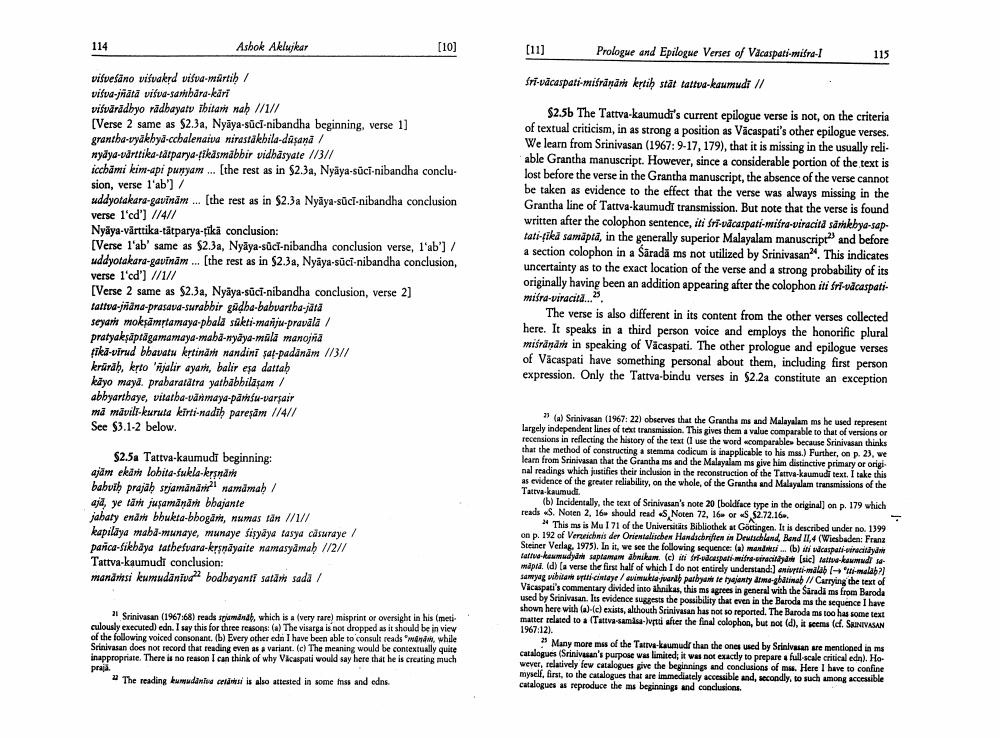Book Title: Prologue And Epilogue Verses Of Vacaspati Misra I Author(s): Ashok Aklujkar Publisher: Ashok Aklujkar View full book textPage 6
________________ 114 Ashok Aklujkar (10) (11) Prologue and Epilogue Verses of Vacaspati-mira-1 115 Sri-vācaspati-misraami krti stat tattua-kaumudi // vifvesano višvakrd vifua martih / vifua.ridtā visua-sandra-käri visvärddbyo radhayatv ibitan nah //1// [Verse 2 same as $2.3a, Nyāya-sūcl-nibandha beginning, verse 1] grantha-vyakhya-ccbalenaina nirestakhila-dasana/ nydya-wirttika-lasparya-fiksmabbir vidhäsyate 1/3// icchami kim-api punyam ... (the rest as in $2.3a, Nyāya-sūcī-nibandha conclusion, verse l'ab') / uddyotakara-gavinam... (the rest as in $2.3a Nyāya-scinibandha conclusion verse l'cd'] 11411 Nyaya-värttika-tātparya-tīkā conclusion: [Verse l'ab' same as $2.3a, Nyaya-sūcl-nibandha conclusion verse, l'ab') / uddyotakara-gavinam... (the rest as in $2.3a, Nyaya-sūcl-nibandha conclusion, verse l'cd') //1/1 [Verse 2 same as $2.3a, Nyāya-suci-nibandha conclusion, verse 2] tattwa-jildna-prasata surabbir gudha-babwartha-jata seyanir mokesāmestamaya-pbald siktimariju-pravala / pratyasprāgamamaya-maba-nyaya mala manojia fikd-wirud bhawatu krtinant nandini sat-padanam 1/3// krürüh, kpto 'rijalir ayam, balir era dattah kayo mayd. prabaraldira yathabbilasam / abbyartbaye, vitatha-drimaya-pantofu-varsair ma māvili-kurula kirti-nadih parejām //4/1 See $3.1-2 below. $2.56 The Tattva-kaumudi's current epilogue verse is not, on the criteria of textual criticism, in as strong a position as Vacaspati's other epilogue verses. We learn from Srinivasan (1967: 9-17, 179), that it is missing in the usually reliable Grantha manuscript. However, since a considerable portion of the text is lost before the verse in the Grantha manuscript, the absence of the verse cannot be taken as evidence to the effect that the verse was always missing in the Grantha line of Tattva-kaumudi transmission. But note that the verse is found written after the colophon sentence, iti Sti-vacaspati-wifra-viracitd sänkeby-saptati-riki samăpta, in the generally superior Malayalam manuscript and before a section colophon in a Saradams not utilized by Srinivasan. This indicates uncertainty as to the exact location of the verse and a strong probability of its originally having been an addition appearing after the colophon iti fri-vdcaspati mitra-viracita.... The verse is also different in its content from the other verses collected here. It speaks in a third person voice and employs the honorific plural mišrana in speaking of Vācaspati. The other prologue and epilogue verses of Vacaspati have something personal about them, including first person expression. Only the Tattva-bindu verses in $2.2a constitute an exception $2.5. Tattva-kaumudi beginning: ajane ekarie Lobita-fakla-krsnanie babvih prajā sejamānanie namdmah / ajd, ye tanir jusamänänh bhajante jahaty endne bhukta-bhogani, numas tan //1// kapilaya maba-munaye, munaye fasyaya tasya căsuraye / panica-Sikhaya tatbesvara-krsmāyaite namasyamah 1/2/1 Tattva-kaumudi conclusion: mandmesi kumudāniu bodhayanti satan sada / (m) Srinivasan (1967: 22) observes that the Granthame and Malayalam ms he used represent largely independent lines of text transmission. This gives them a value comparable to that of versions or recensions in reflecting the history of the text (I use the word comparable because Srinivasan thinks that the method of constructing a stemma codicum is inapplicable to his mss.) Further, on p. 23, we learn from Srinivasan that the Grantha ms and the Malayalam ms give him distinctive primary or origi nal readings which justifies their inclusion in the reconstruction of the Turvakaumudi text. I take this as evidence of the greater reliability, on the whole of the Grantha and Malayalam transmissions of the Tattvakaumud (b) Incidentally, the text of Srinivasan's note 20 [boldface type in the original) on p. 179 which reads S. Noten 2, 16w should read S Noten 72, 16 or S 52.72.16 # This meis Mo 1 71 of the Universität Bibliothek s Gottingen. It is described under no. 1999 on p. 192 of Versichnis der Orientalischen Handschriften in Deutschland, Band 114 (Wiesbaden: Franz Steiner Verlag, 1975). In it, we see the following sequence: (a) mass . (b) dicaspati-sitecity tattw.kaumudyan saptantum abrukan ( d iri-capalmifresi (sic) a kawa mdp. (d) (a verse the first half of which I do not entirely understand:) anti-dlab I ni-melab? Sanyag wibutant specintay / ewimbajando parbyani te hanty atmo-gbatinab // Carrying the text of Vicaspati's commentary divided into thnikas, this ms agrees in general with the Siradāms from Baroda used by Srinivasan. Its evidence suggests the possibility that even in the Baroda ma the sequence I have shown here with (a)- exists, althouth Srinivasan has not to reported. The Barodams too has some text matter related to a (Tutva-semisalut after the final colophon, but not (d), it seems id. SRINIVASAN 1967:12). Many more mus of the Tattvakaumud than the ones used by Srinivasan are mentioned in me catalogues (Srinivasan's purpose was limited, it was not exactly to prepare a full-scale critical edin). However, relatively few catalogues give the beginnings and conclusions of mss. Here I have to confine myself, first, to the catalogues that are immediately accessible and secondly, to such among accessible Catalogues as reproduce the ms beginnings and condusion Srinivasan (196768) reeds met which is a very rare misprint or oversight in his (meti culously executed edn. I say this for three reasons: (a) The viatge is not dropped as it should be in view of the following voiced consonant. (b) Every other edin I have been able to consult reads , while Srinivasan does not record that reading even as a variant. (e) The meaning would be contestually quite inappropriate. There is no reason I can think of why Vacaspati would say here that he is creating much prac The reading madania celana is also attested in some foss and edins.Page Navigation
1 ... 4 5 6 7 8 9 10 11 12 13 14
